Results of the State of Marriage Survey
The data paint a damning portrait of the effects of marriage on heterosexual women.
Photo by Beatriz Pérez Moya on Unsplash
The results are in! More than a thousand of you responded to the State of Marriage survey, giving a clear picture of what marriage offers—and doesn’t. Read on to learn more.
The Typical Cisgender Heterosexual Marriage
This was not a representative sample. There were flaws in the data collection, flaws in the questioning, gaps in data, and more. I didn’t control at all for demographics, which means that some groups (indigenous women, white women, nonbinary people) were represented at much higher numbers than in the general population.
I’m not a statistician or a pollster. And of course, the data is limited to my audience—feminist people who recognize that marriage is often problematic. That probably includes both a larger proportion of people with feminist marriages and a larger share of people with problematic marriages. So with these caveats, here’s some of what I saw:
Abuse in Marriage
Abuse was extremely common. Among married, heterosexual women:
42.44% reported having partners who used anger to attempt to control them.
35.62% said their partners use sexism as a weapon in fights.
42.35% say they have felt afraid of their partners.
19.9% say their partners have hit, punched, slapped, or otherwise assaulted them.
30.98% say their partners have thrown or broken things in anger.
28.77% say their partners call them names.
Household Labor Distribution
By every measure, and no matter how I calculated household labor, married cisgender women in heterosexual relationships are doing significantly more work than their partners—this includes both household labor and work outside of the home. They have less free time, more commitments, and enjoy less sleep. Even women who worked overtime (more than 40 hours per week) did significantly more labor than their spouses.
Some data highlights include:
Even when women’s male partners did not work for pay at all, women did significantly more housework. Among married women who work who have partners who do not work 73.68% still do more household labor than their partners.
Women who work full-time whose partners also work similarly still report doing more housework. 73.87% reported doing 60% or more of household labor, and 89% reported doing more than half.
Women are shouldering an overwhelming volume of household labor, as these charts from all survey respondents (those who work part-time, full-time, and those who do not work for pay) show:
Happiness in Marriage
Marriages were basically evenly split between happy and unhappy, though slightly more women reported being unhappy than happy. 50.75% reported being in unhappy marriages, with 44.08% saying they were happy. About half (52.81%) said they would get married if given the chance to do it all over again.
Hundreds of participants added additional comments about their marriages in the free answer section. I’ll be posting these in batches of 10 on my Instagram and Facebook pages.
On every measure, women married to women reported greater happiness, less conflict, less violence, more sex, more orgasms. Marriage was overwhelming better. But the total sample size of women married to women was small, so we can’t draw conclusions from it.
Free Time
Married cisgender women get almost no free time. Most are getting less than 3 hours per week.
Cisgender married men get significantly more time, with the majority getting at least an hour a day, and many getting much more.
This, to me, is the most damning measure of household equity. It makes sense that in households where one partner works more, the other would do more household labor, so we can’t look at household labor alone. When we look to free time, though, it becomes very clear: men are buying free time with free labor from exhausted, abused, unappreciated women.
Sex and Marriage
Most women are not orgasming most of the time with sex. 47.76% reported having an orgasm 70% of the time or more. 26% said they had an orgasm 10% of the time or less.
Most of us have probably heard that married couples have sex 2 to 4 times a week. The survey makes clear that this isn’t even close to true. Less than 4% of couples had sex at this frequency or greater. As for everyone else? See for yourself.
Among women who did 60% or less of household labor, though, things looked a bit different. They had sex more frequently, were less likely to be in a sexless marriage, and were slightly more likely to have sex more than 10 times a month.
So what factors correlated with more frequent sex? People with the following attributes were more likely to report having sex at least once a week (4 or more times a month) on average:
Women who orgasm 70% or more of the time during sex.
People who report being mostly happy or extremely happy in their relationship.
Women in relationships with other women.
People who do not have children.
Women whose partners do at least 40% of the household labor.
Women who get more than 3 hours per week of personal time.
Women whose partners always get them gifts for holidays.
Women whose partners do not call them names, do not use sexism as a weapon, have not hit them, and who have not made them afraid.
Women who get more than 6 hours of sleep per night.
Women who say that their marriage is better than average.
Egalitarian Marriage as a Key Predictor of Marriage Happiness
Equal or mostly equal households were, as I predicted, happier households. This suggests a strong correlation between household equity and marriage quality. Chore equity might just be the single measure that matters most for marriage happiness.
See for yourself:
Life in Egalitarian Households
In households where domestic labor was more evenly split—specifically in which the woman did 60% or less of household labor—virtually every measure of marriage quality was better:
49% said they were mostly happy, and 21% said they were extremely happy.
89.42% said their partners never called them names.
85.1% said their partners never threw or broke things in anger.
91.83% said their partner had never assaulted or hit them.
76.92% said they had never been afraid of their partners.
87.92% said their partners never used sexism as a weapon.
56.73% got 6-7 hours of sleep or more per night.
65.38% said their marriage was better than average.
65.02% said they had an orgasm 70% of more of the time during sex.
85.26% said their partner never used anger to control them.
86.56% reported that, given the chance, they would get married again.
7.89% reported being unfaithful to their partners.
8.42% said their partners had been unfaithful.
Life in Unequal Households
So what does life look like in unequal heterosexual marriages? In marriages where women did 60% or more of household labor, every measure of marriage quality was worse:
45.1% reported being mostly or extremely unhappy; 23.49% said they were mostly happy, and 6.41% said they were extremely happy.
66.46% said their partner never called them names.
35.21% said their partners threw or broke things in anger.
74.59% said their partners had never assaulted or hit them.
52.57 percent said they had never been afraid of their partners; 47.43% reported being afraid of their partners.
58.22% said their partners never used sexism as a weapon.
42% got 6-7 hours of sleep or more per night.
41% said their marriage was worse than average, and just 26.47% said it was better.
43.26% reported orgasming 70% of the time or more during sex.
50.07% said their partners used anger to control them.
56.27% said, given the chance, they would not get married again.
11.21% reported being unfaithful to their partner.
21.07% reported that their partner had been unfaithful.
Neurodivergence and Household Equality
In articles on household equity, writers often tell women to learn about their partners’ ADHD, autism, and other forms of neurodivergence—demanding more emotional labor from people who are already shouldering a disproportionate share of the burden. In the comments to the survey, dozens of participants reported that the reason they had to do more of the household labor was that their partners were neurodivergent.
That support extended in only one direction. When women were neurodivergent, they did not get more support from their spouses. 83.22% of women whose male partners were neurodivergent did 60% or more of household labor:
The figures were almost identical when women were neurodivergent: 80.48% of neurodivergent women did 60% or more of household labor.
It’s just as I suspected: neurodivergence functions as an excuse for men, but not for women.
I’ve learned a lot from this survey. There are questions I wish I had asked, or asked differently. And I’m planning to do more research. One of the first items on my agenda list is to assess the postpartum experience for married heterosexual women—how much their partners support them, how it affects mental health, birth experience and partner support, etc.
What data would you like to see next? Please consider leaving it as a comment, and I may include it in the next round of surveys.




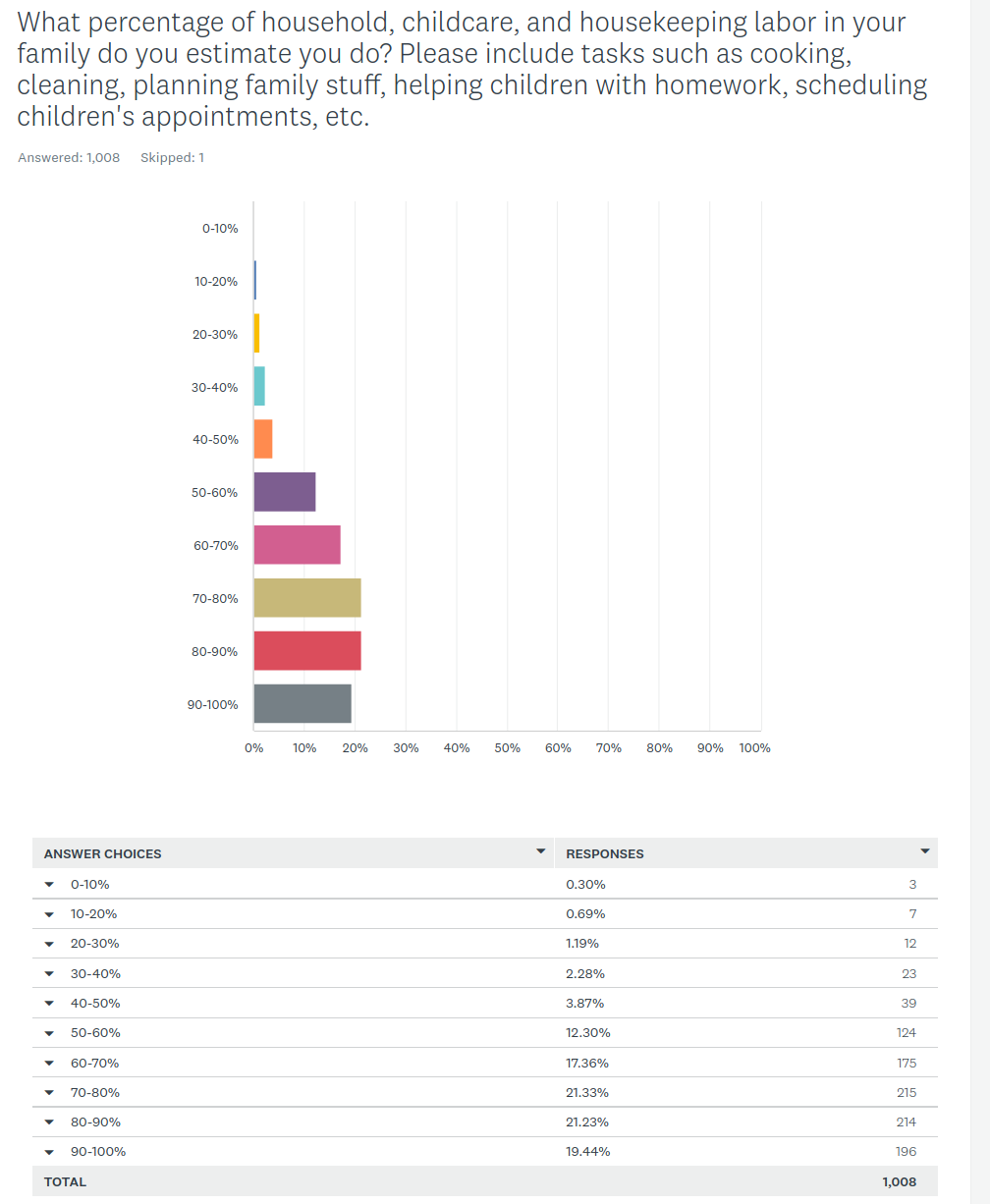
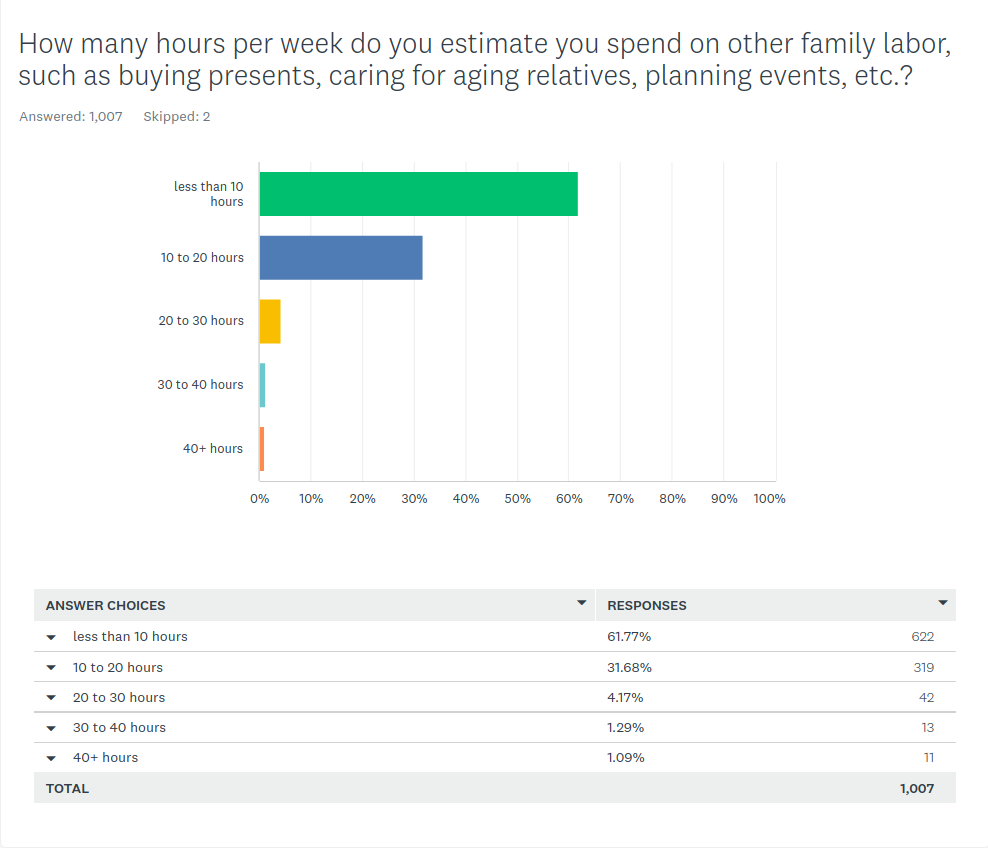
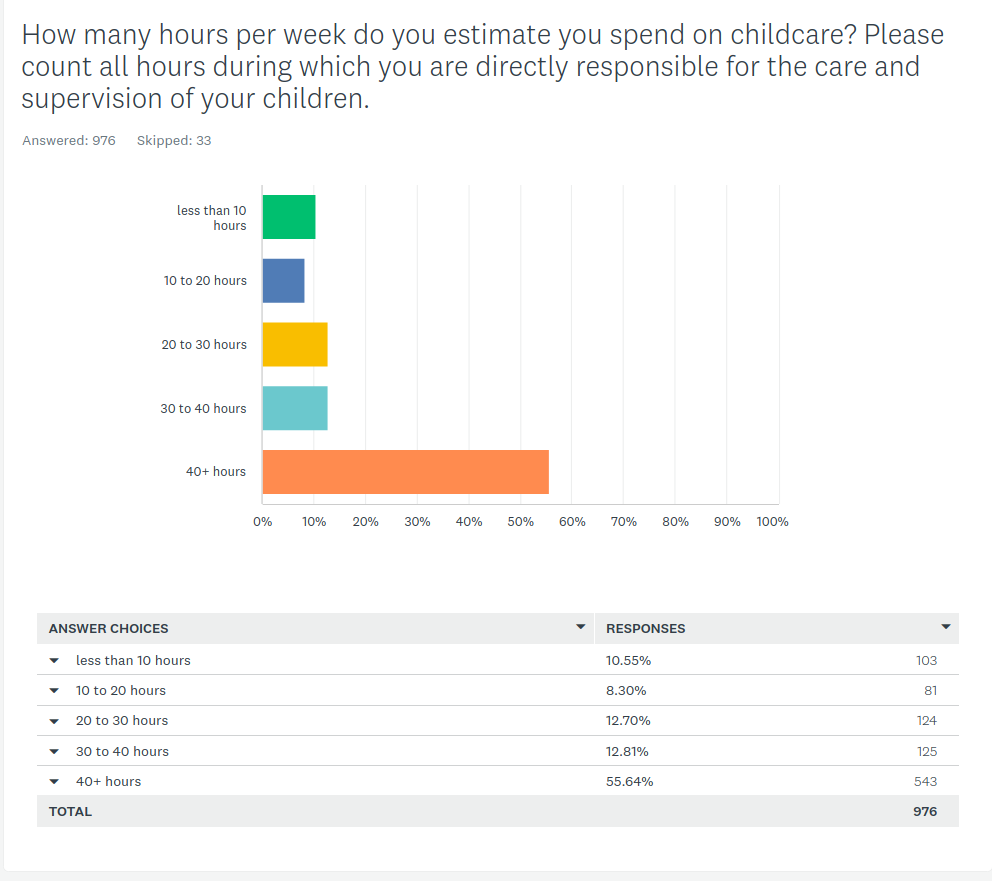
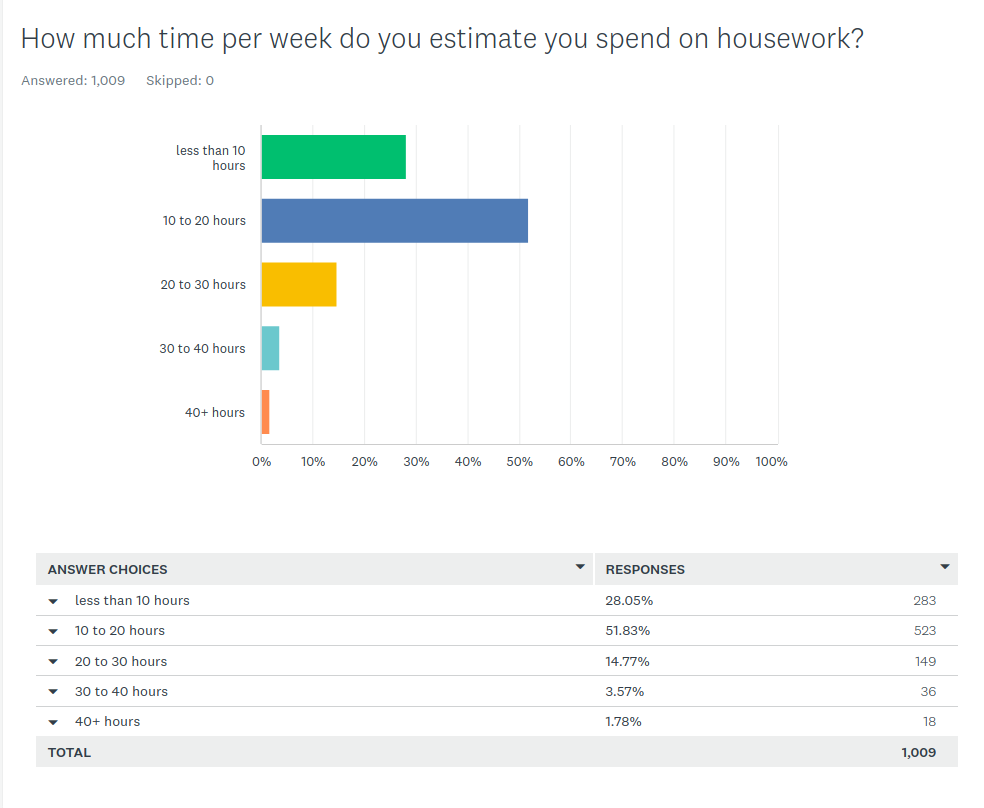
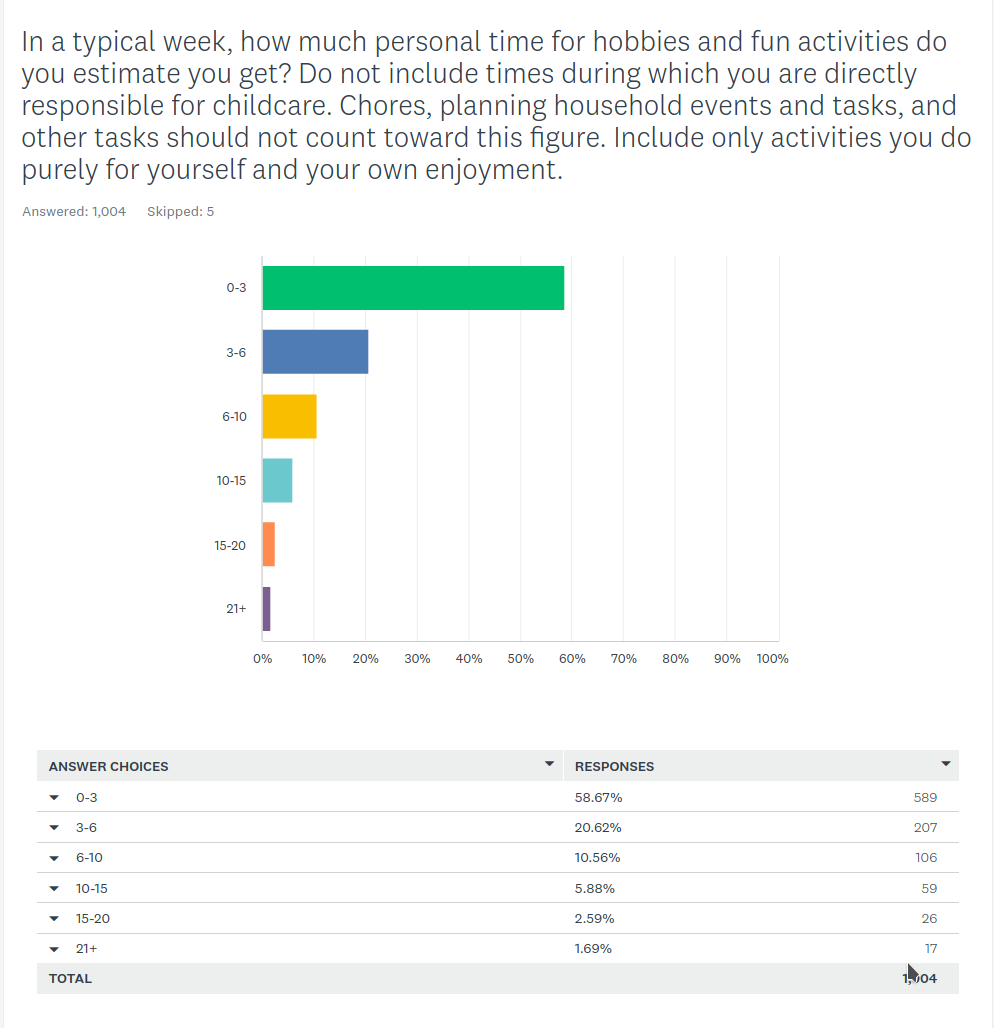
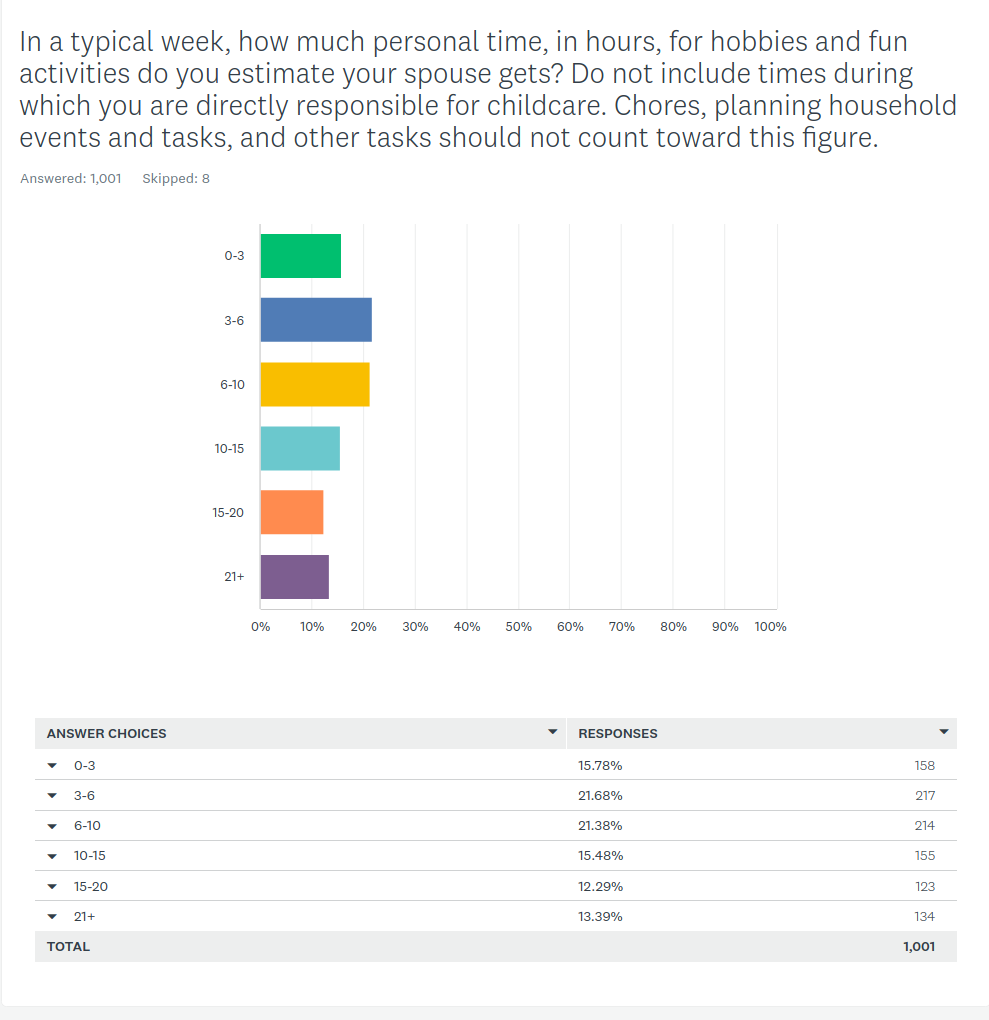
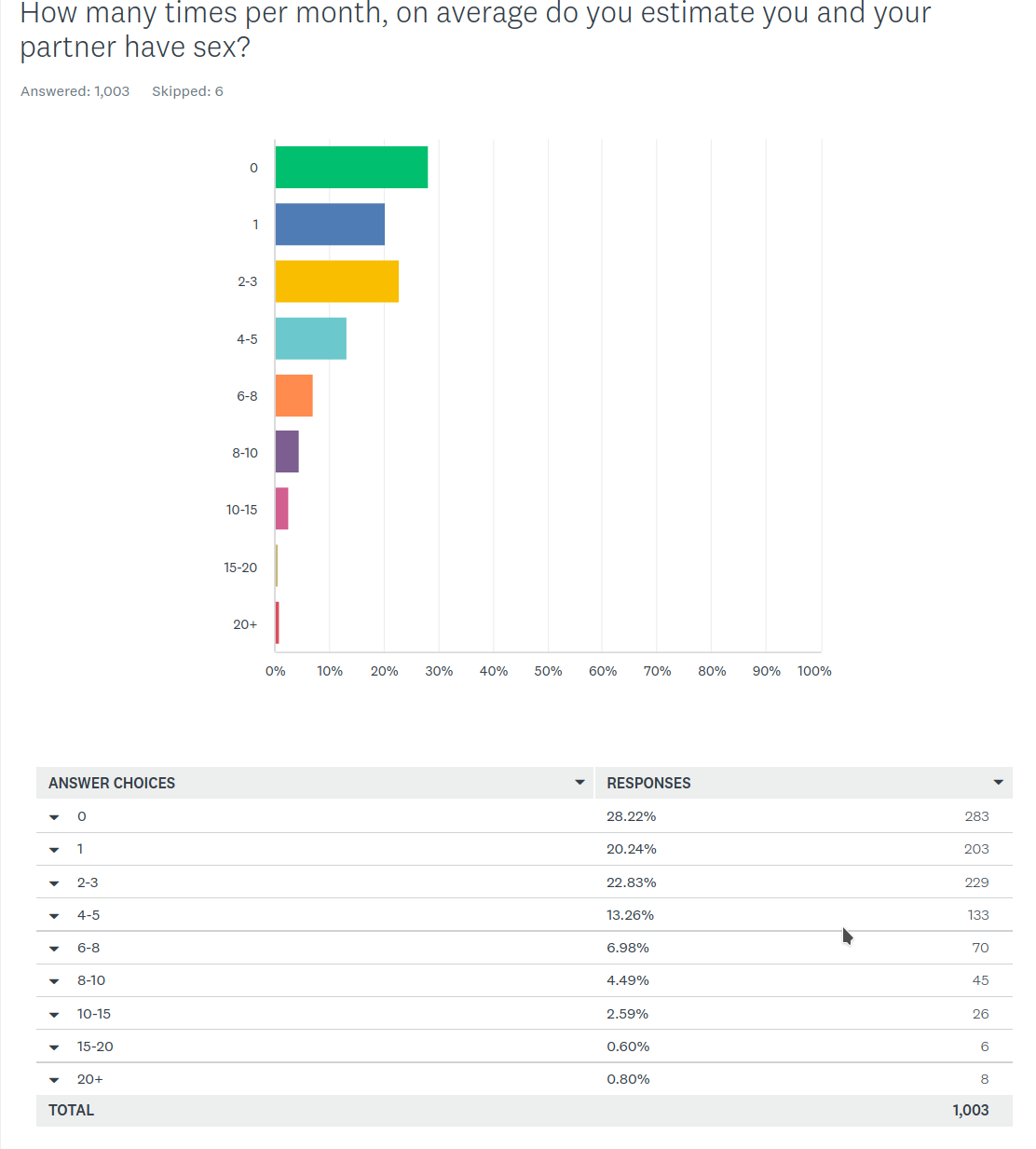
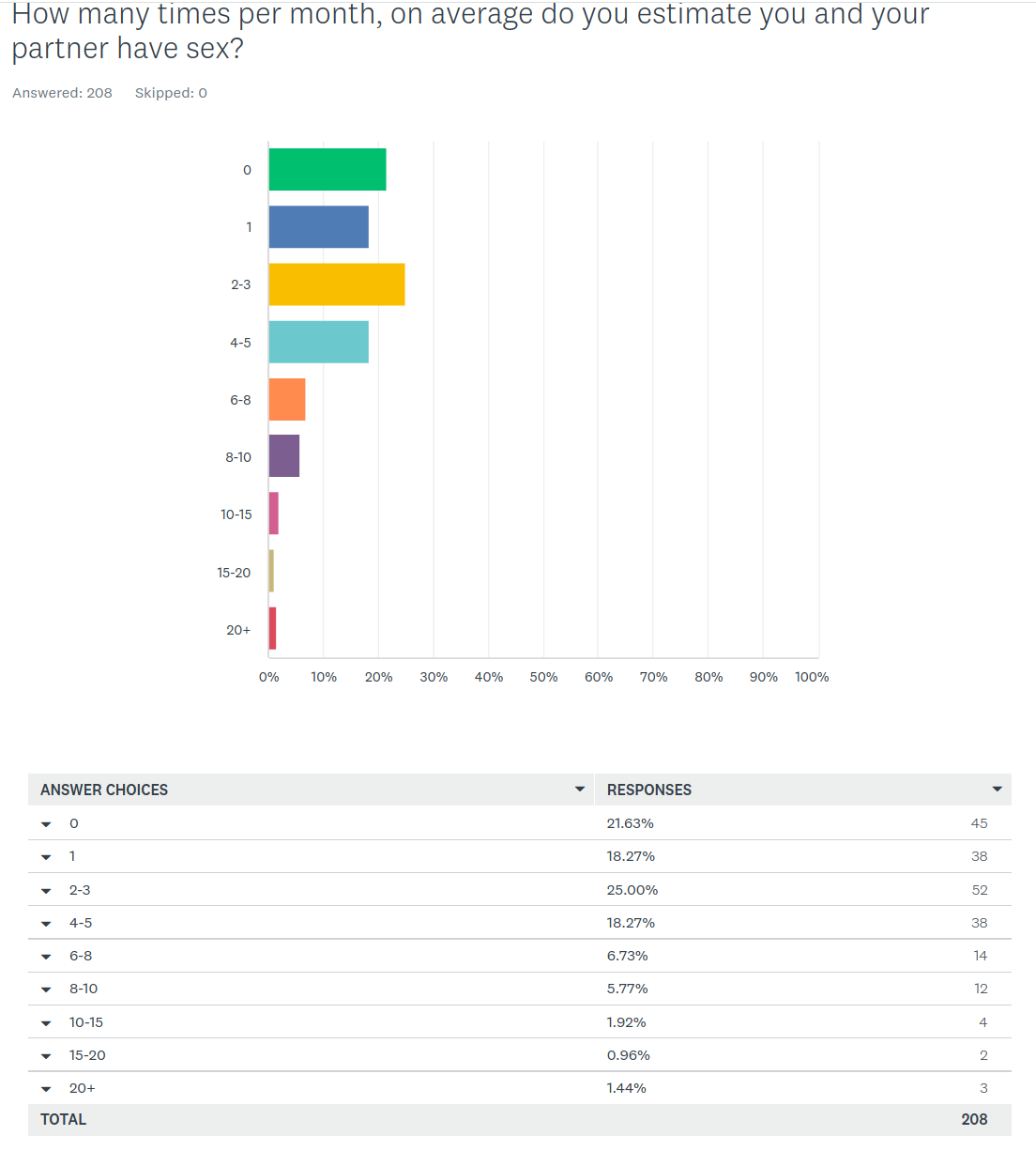
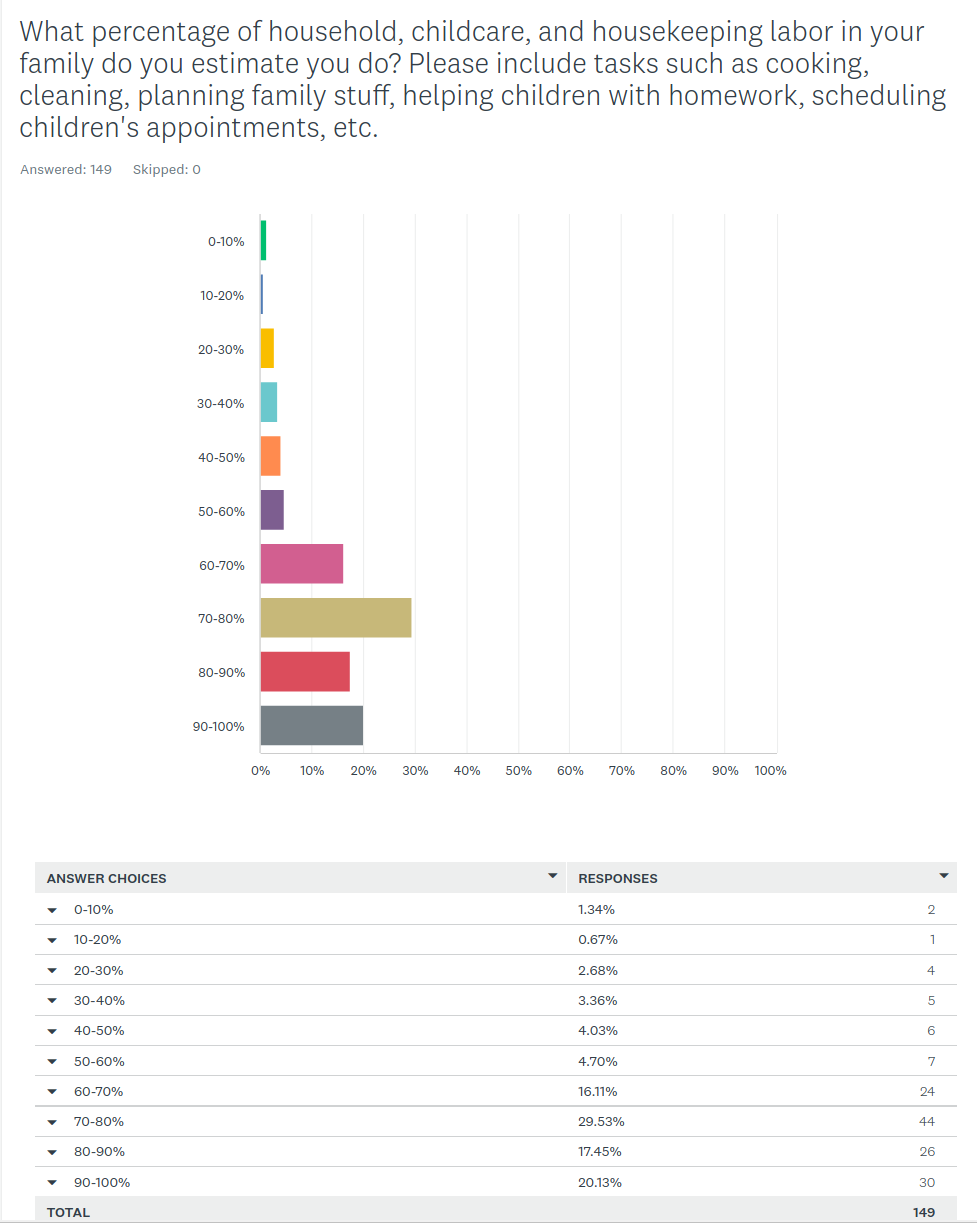
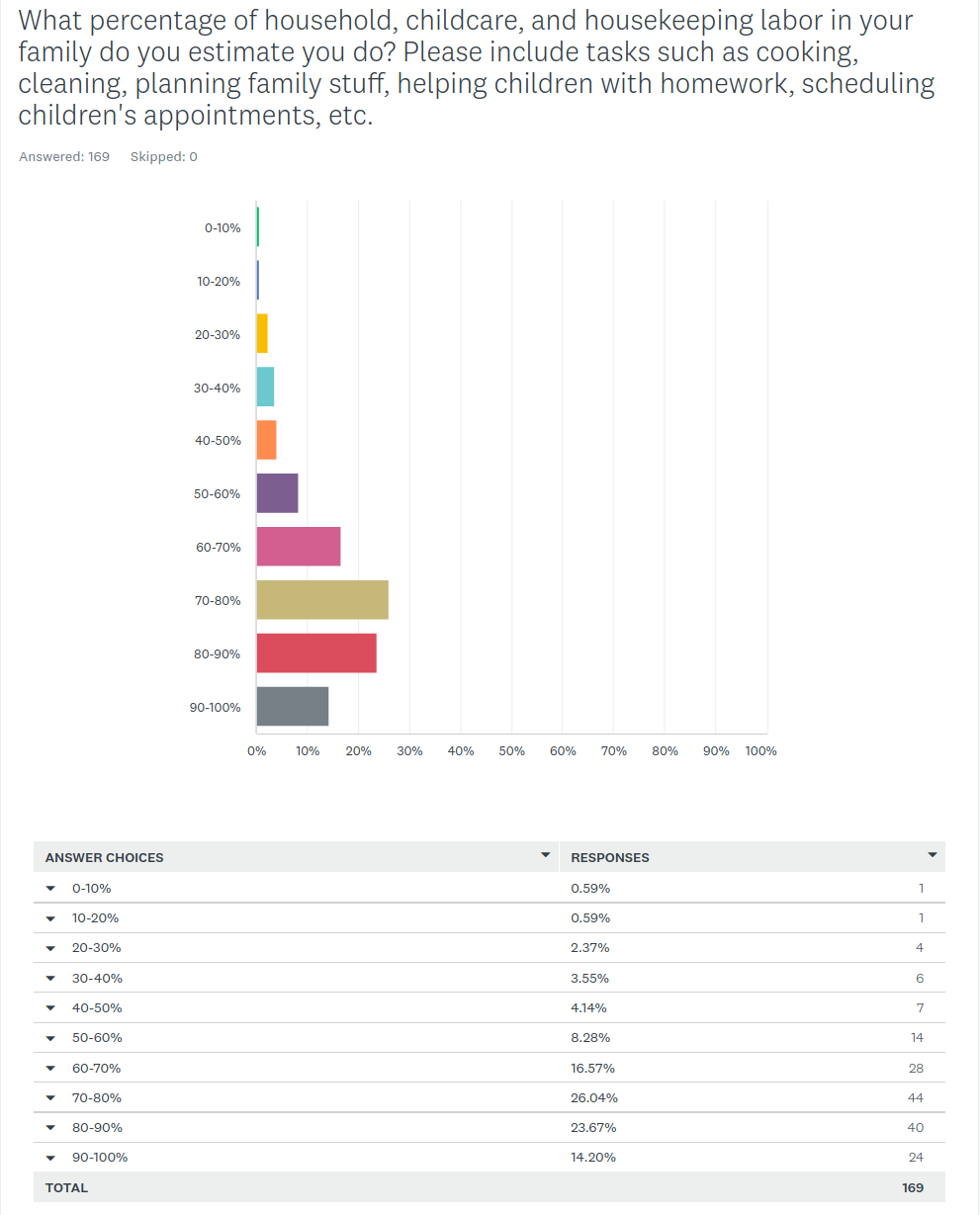
I’d be interested in data on the amount of parental leave partners took (and maybe when that leave occurred) in relation to things like happiness and household caretaking/responsibilities. I’ve heard a lot about how taking parental leave helps establish better equity early on. So I’d be curious whether there are differences in the amount of leave partners take, whether it’s concurrent with the birthing parent vs staggered, etc.